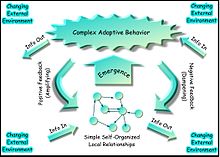
Biological network inference is the process of making inferences and predictions about biological networks.[1] By using these networks to analyze patterns in biological systems, such as food-webs, we can visualize the nature and strength of these interactions between species, DNA, proteins, and more.
The analysis of biological networks with respect to diseases has led to the development of the field of network medicine.[2] Recent examples of application of network theory in biology include applications to understanding the cell cycle[3] as well as a quantitative framework for developmental processes.[4] Good network inference requires proper planning and execution of an experiment, thereby ensuring quality data acquisition. Optimal experimental design in principle refers to the use of statistical and or mathematical concepts to plan for data acquisition. This must be done in such a way that the data information content is enriched, and a sufficient amount of data is collected with enough technical and biological replicates where necessary.[citation needed]
- ^ Mercatelli D, Scalambra L, Triboli L, Ray F, Giorgi FM (June 2020). "Gene regulatory network inference resources: A practical overview". Biochimica et Biophysica Acta (BBA) - Gene Regulatory Mechanisms. 1863 (6): 194430. doi:10.1016/j.bbagrm.2019.194430. PMID 31678629. S2CID 207895066.
- ^ Barabási AL, Gulbahce N, Loscalzo J (January 2011). "Network medicine: a network-based approach to human disease". Nature Reviews. Genetics. 12 (1): 56–68. doi:10.1038/nrg2918. PMC 3140052. PMID 21164525.
- ^ Jailkhani N, Ravichandran S, Hegde SR, Siddiqui Z, Mande SC, Rao KV (December 2011). "Delineation of key regulatory elements identifies points of vulnerability in the mitogen-activated signaling network". Genome Research. 21 (12): 2067–2081. doi:10.1101/gr.116145.110. PMC 3227097. PMID 21865350.
- ^ Jackson MD, Duran-Nebreda S, Bassel GW (October 2017). "Network-based approaches to quantify multicellular development". Journal of the Royal Society, Interface. 14 (135): 20170484. doi:10.1098/rsif.2017.0484. PMC 5665831. PMID 29021161.
© MMXXIII Rich X Search. We shall prevail. All rights reserved. Rich X Search
